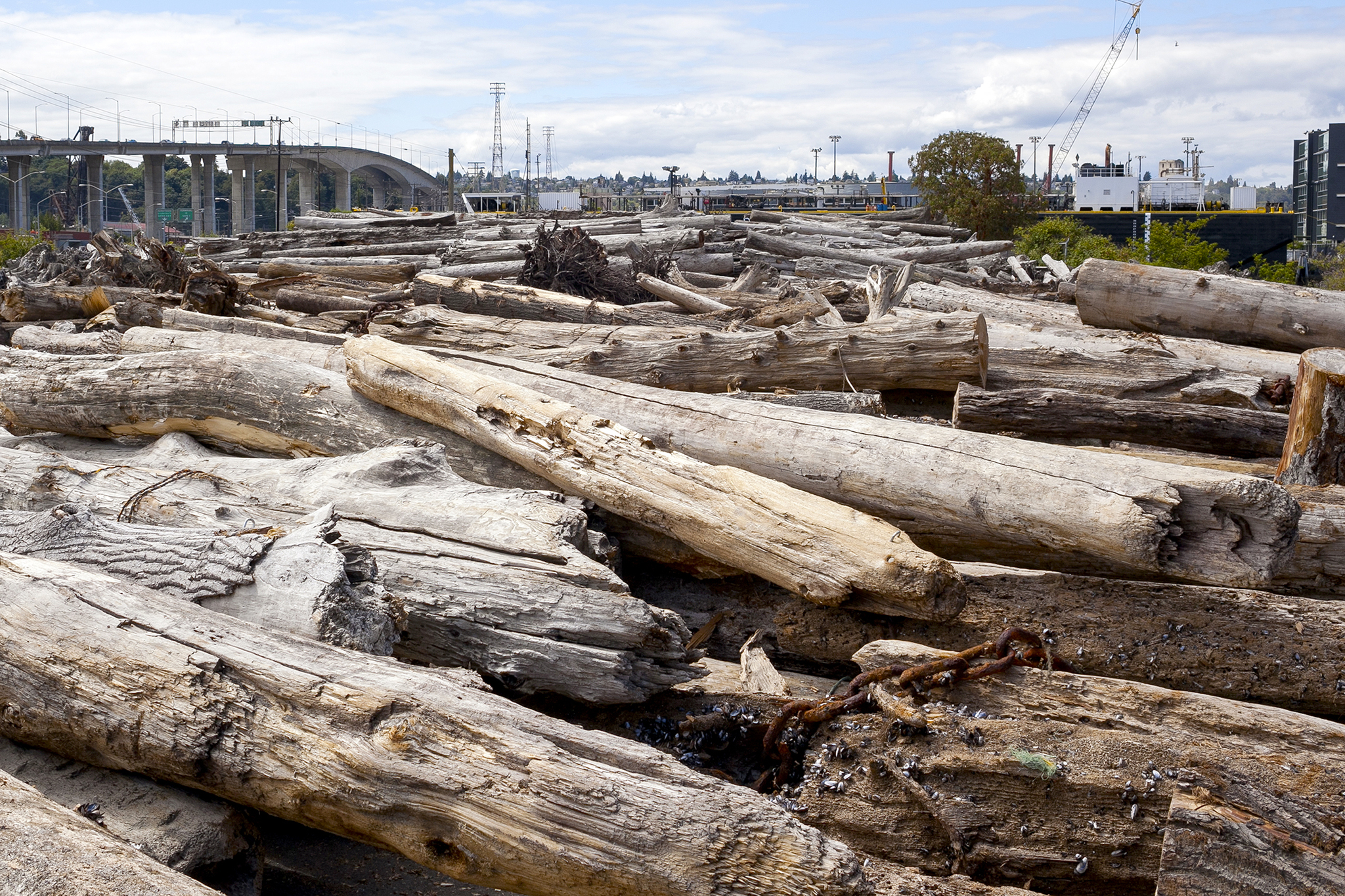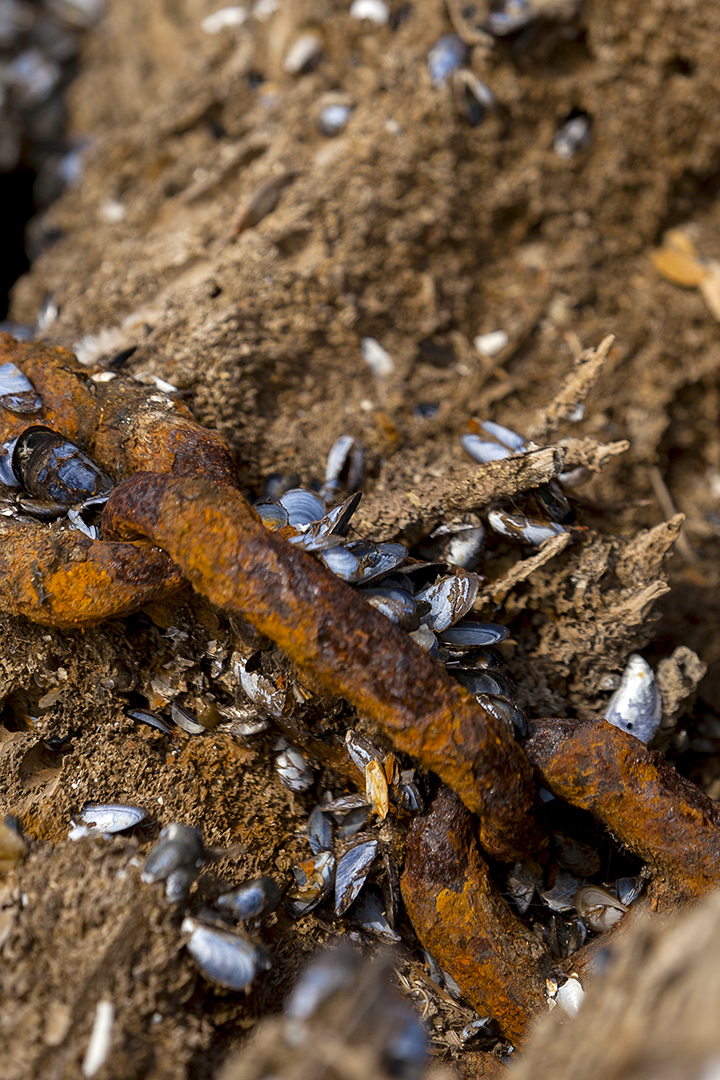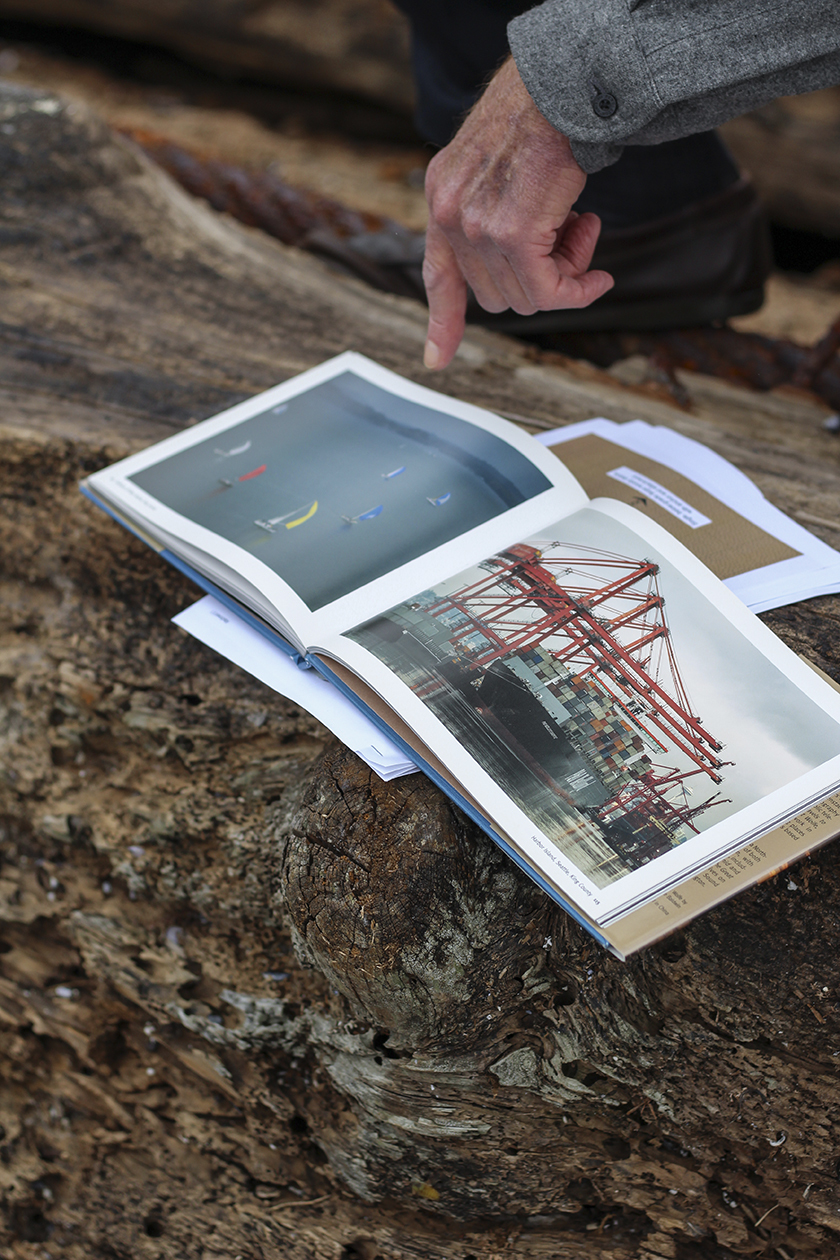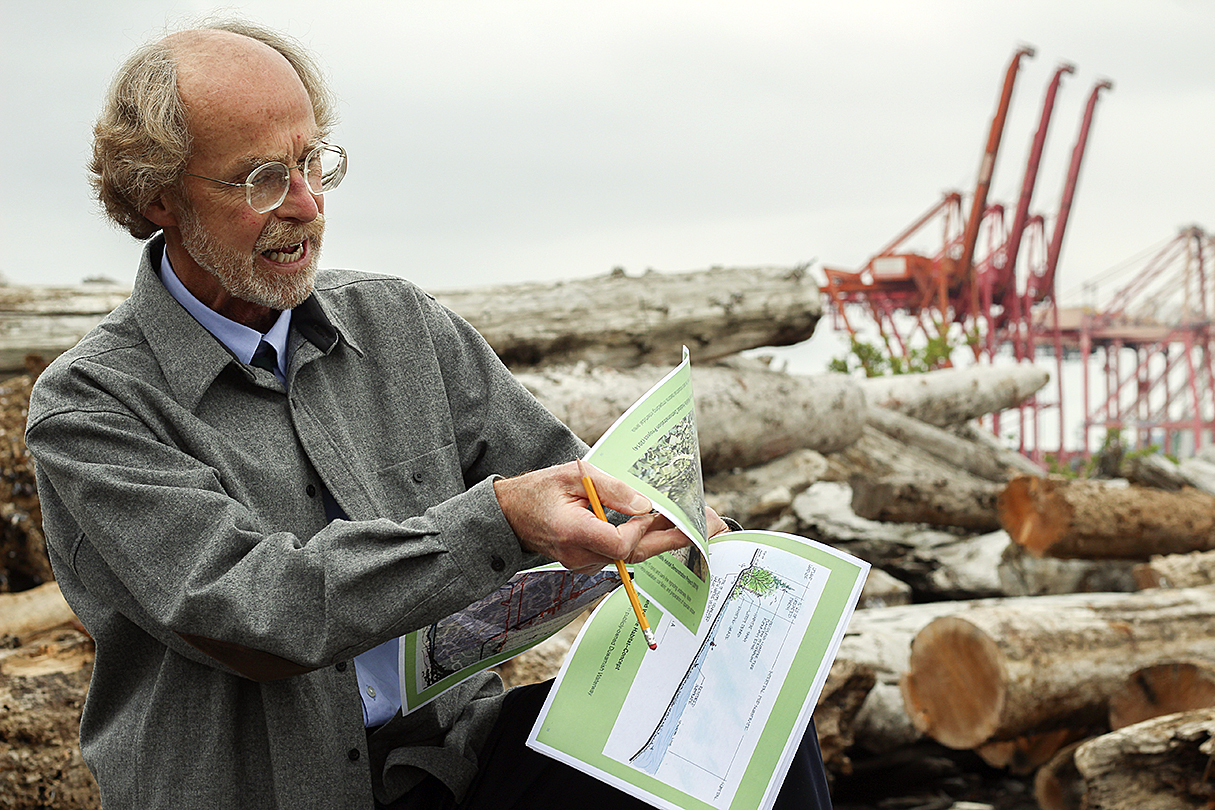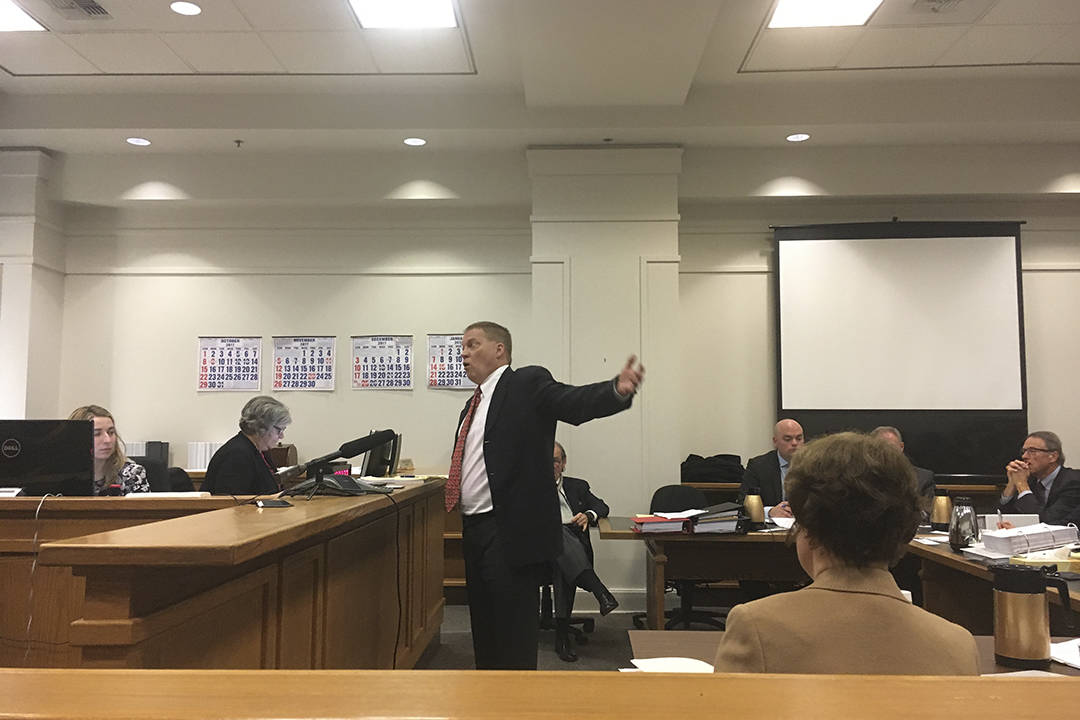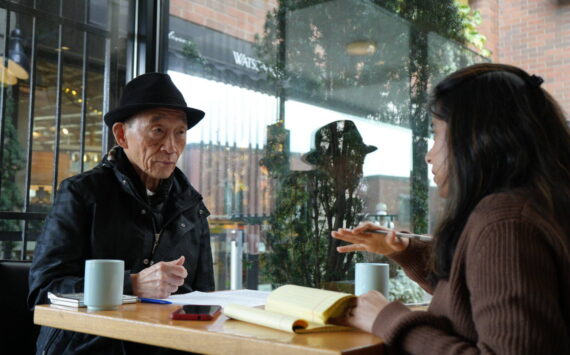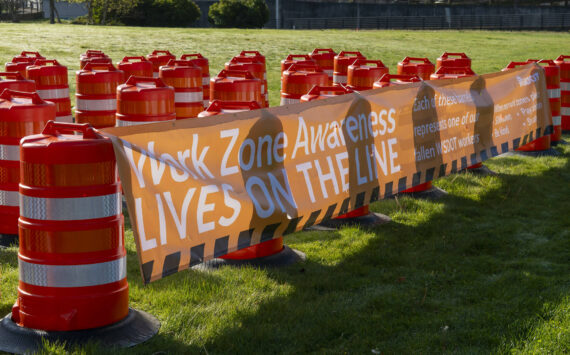There are places in the world that just seem to attract history. Rome is one. The Port of Seattle’s Terminal 25 is another.
An enormous amount of Seattle history can be told on a quick walk around the grounds, now overgrown and out of use. The terminal looks out across Harbor Island, created by fill from the Dearborn and Jackson Street regrades to become the largest artificial island in the world when it was finished in 1909 and still the largest in the United States. Then there’s the white gravel that crunches underfoot. Upon close examination you see it is concrete; you are walking on the remains of the Kingdome, shattered into a billion pieces. The imploded municipal project needed to go somewhere. In all directions, the busiest intersection of commerce in the state rumbles at a constant din as container ships, locomotives, and highway overpasses meet at the intersection of land and sea.
But perhaps the most interesting corner of this easy-to-miss lot is where 1,200 tons of driftwood—all of it fished from Puget Sound—is stacked neatly in 12-foot-high piles. Like the dirt and the gravel, the logs too seem to want to tell stories of their past. From some hang giant rusted chains of obscured purpose; others retain their massive roots, speaking to some forgotten spring-runoff cataclysm in the wilds of Washington—the kind of annual event that can snap centuries-old trees like toothpicks.
“We’ve got Doug fir, cedar, cottonwoods,” George Blomberg says as he clambers over the woody stash.
Blomberg, senior environmental program manager for the Port of Seattle, is also the source of all kinds of tidbits about Terminal 25. He wears a Pendleton coat with professorial leather elbow patches. Another piece of history from Blomberg: Where the wood sits now was once the site of a massive mill, where timber would come in on barges from across around the Sound to be turned into lumber. “And I’ll be damned if we’re not docking wood here again!” Blomberg barks, gold fillings flashing in the back of his mouth.
In the past, Washington logging was seen as a foe of much of Mother Nature. In particular, clear-cuts helped destroy the streams that are vital to spawning salmon. The wood now stacked at Terminal 25 serves an opposite purpose: to help usher in a new chapter of Seattle history, one in which the Duwamish again serves as a thriving artery between those spawning streams in the Cascades and the waters of Puget Sound.
“We’ve lost 99 percent of the [salmon] habitat in the estuary,” Blomberg says, referring to the river’s ecologically vital but heavily industrialized portion, where saltwater from the Sound and freshwater from the mountains mix in a brackish stew. This loss of habitat is not ideal for any living organism not directly involved in the import/export business, but it is particularly harmful to juvenile salmon making their way from the mountains to the sea.
For the young fish, the slightly salty water of the lower Duwamish serves as a sort of prep area. Under normal circumstances, they would linger in the estuary to get acclimated to saltwater, in anticipation of the main event of their lives: a spell in the open sea, where they will grow to the size of Queen Elizabeth’s corgis, dodging predators like orcas for whom they are a vital food source, until they eventually come back upriver to spawn and start the process anew.
However, for fish to use the Lower Duwamish, they need food and protection. Much of the industrialized river offers neither. In the process of turning the Duwamish River—once a braided, meandering channel prone to spring flooding—into what’s essentially a shipping canal, engineers have over the past century lined the riverbanks with rocky rip-rap. The rip-rap stabilizes the shore but doesn’t encourage any kind of vegetation, and as a result sits entirely barren.
That’s where the driftwood comes in.
As anyone who has hiked in the Cascade Range knows, Pacific Northwest rivers are very often clogged with trees ripped from the ground by swelling rivers. But they are more than the simple detritus of a violent world; scientists have come to recognize that these logs serve important biological purposes, chief among them creating the knotty shorelines that fish love. Scientists have even come up with a fancy name for what most people would simply call dead trees: Large Woody Debris.
But in a body of water like the Duwamish, where there is a significant amount of boat traffic, allowing the titanic trunks of Sitka spruce to float around freely is not an option. Driftwood that does come down the river is quickly removed to keep navigation lanes clear of obstacles. Yet even without this nautical intervention, debris would struggle to find good purchase on the steep, armored shores of the Duwamish today.
So Blomberg intends to reverse-engineer the process: Rather than allowing logs to flow downriver from the mountains, he’s bringing them upstream from the Sound.
If all goes according to plan, in coming years the logs now stacked at Terminal 25 will be anchored up and down the Lower Duwamish Waterway with massive chains that can hold in place logs with enough buoyancy to lift a large pickup. Once in place, Blomberg expects the spindly fingers of the driftwood’s roots to act like a net, catching bugs and other organic material as it drifts downstream, creating caches of calories for hungry fish. Furthermore, as they deteriorate, the logs will also fertilize plants and trees planted above them, which will provide shade and more calories for fish as bugs drop off their leaves and into the water. Blomberg says studies suggest that natural shorelines like the ones he hopes to create produce five times as many calories for fish as the rocky shores now dominating the river.
The logs come courtesy of the Army Corps of Engineers, which operates a vessel, The Puget, whose primary mission is to keep snags out of the Sound’s navigation channels. Every year, the Puget scoops about 1,000 tons of wood from the water, from Olympia to the San Juans. In the past, most of that wood went to contractors, who repurposed it for everything from paper pulp to furniture. But starting two years ago, much of it gets dumped at the Port of Seattle’s doorstep for Blomberg’s big project.
“If you think about what salmon do—swim upriver—we’re kind of doing the same thing. We’re taking wood from the Sound and pulling it up the Duwamish,” he says. “I hope that’s not too poetic.”
The Duwamish hosts five species of salmon. Many of their runs are currently imperiled, but none more than the Chinook’s.
Every step in a salmon’s life cycle has been challenged by human development, from the moment it hatches from an egg in a freshwater stream and is carried by gravity toward the ocean, growing and strengthening as it goes, to its adulthood in the Pacific’s salty waters and then its return to the stream it was spawned in to reproduce. But its most perilous time is the juvenile phase. While fish ladders allow adult salmon to get past dams and access spawning grounds, no good solutions exist to allow young salmon easy passage back downstream. Then you have the heavy development along the lower river, which lacks not only many of the fish’s natural food sources but also shade to keep water temperatures cool; American Rivers, a national environmental organization, reports that the Duwamish/Green River can warm up to fatal temperatures for lack of shade. Finally there is the lack of vital estuary habitat.
According to American Rivers, as few as 800 Chinook salmon have been counted returning to the Duwamish/Green river watershed in a year—about 10 percent of their historic numbers.
Consider that the Duwamish’s depleted salmon runs are fairly typical among Washington rivers, and you begin to understand the critical state that natural salmon runs are in.
Clearly, driftwood alone—even 1,200 tons of it—won’t solve the problem. Yet the Port’s efforts come at a time when scientists are just beginning to understand the value of these logs in the Puget Sound ecological puzzle.
Some of the most extensive research has been conducted by scientists at the University of Washington’s Friday Harbor research center. In recent years, researchers led by Megan Dethier began to look into the effect on salmon of “armored” beaches, which, much like the banks of the Duwamish, are treated with rocks and concrete to prevent erosion. The practice is common around beachside developments where loss of shoreline equals loss of property value. It has long been suspected that armored beaches are detrimental to shoreline ecology, but no one had strong data on just why that was until Dethier and her colleagues investigated.
Their research found that natural beaches accumulated 18 times as much driftwood as armored beaches. This driftwood, along with other woody debris, proved to be the foundation on which a largely unseen web of life is built. Within its shelter and shade, tiny invertebrate species—bugs and worms and flies—were vastly more abundant than along the armored shores placed by humans who built their homes too close to the beach; in some cases, invertebrate species were eight times more numerous along the drift-strewn beaches. Salmon took notice. Using snorkel gear, researchers went underwater to observe how salmon behaved around beaches strewn with woody debris, and found that they lingered much longer than they did at armored beaches, presumably appreciating the bounty of food provided by all that teeming wrack washed up from the sea.
Turns out salmon enjoy picnicking by driftwood on a beach as much as humans do. The research was yet further evidence that everything plays its ecological part.
Even prior to Dethier’s research, scientists had a good idea, if not strong data, that driftwood was important for the environment. Many state beaches have strict bans on the removal of driftwood, which at times has grated on those who see it as nothing more than salted deadfall.
Over on Vashon Island in 2009, a veritable whodunit erupted as residents began alerting authorities to a mysterious driftwood-harvesting operation along the island’s southern beaches. While at first no law-enforcement division was really sure such a crime was its responsibility, the King County Sheriff’s Office finally took up the case and caught the pirate wood-handed. According to the Vashon-Maury Island Beachcomber newspaper, he told deputies he was being paid by a chipping company in Edmonds to harvest driftwood. Informed doing so was a crime, he agreed to stop. No charges were filed.
Dethier’s research did not address estuary environments like the lower Duwamish per se, though she says in a phone interview that the same principles should apply. “The wood provides good habitat for bugs for salmon to eat, shade, all kinds of things,” she says. “People may ask, ‘Why put a bunch of logs there?’ But the data does exist that they have real potential value.”
Down in Oregon, a team of researchers did study the impact of natural wood-strewn estuaries on salmon and came away with promising—if not conclusive—results. By watching juvenile salmon, or “salmonoids,” near large woody debris in an estuary, the scientists found evidence both that more salmon were found around the logs and that food was more abundant.
Jeffery Cordell, a fisheries researcher at the University of Washington, cautions that much is still unknown about the value of driftwood in estuaries like the Duwamish, but “anything is better than rocks or concrete and sheet piles,” he says of the Duwamish project, which he’s been briefed on but is not involved in. The driftwood “is going to eventually degrade and create organic materials. It may even itself be colonized. That’s all going to become more of a functioning ecosystem than a rock wall will be.”
Last year, the Port of Seattle completed a small demonstration project of restored natural shoreline at Terminal 108, near the Liquor Control Board building on East Marginal Way.
To the naked eye, the restored shore may seem underwhelming: logs lain end-to-end, dark chains wrapped around the trunks, small shrubs growing up through freshly mulched ground. In fact, T-108 is just the latest territory clawed back from the industrialization that has defined the Duwamish for 100 years. Prior to European settlement, the South Elliott Bay estuary measured some 5,300 acres—a combination of marsh, swamp, and intertidal mud. By 1985, that figure stood around zero.
While the Port’s legacy in this history is mixed, to say the least—it is after all one of the main responsible parties in the Superfund cleanup now underway along the Duwamish—its efforts to restore what natural habitat it can on the river date back 20 years. That’s when the Port began restoring Turning Basin, which had been used industrially for 90 years. A desolate wasteland punctuated by a massive, rusted-out ship’s hull, Turning Basin was degradation at its filthiest. Yet today it is a thriving wetland where herons, eagles, and salmon alike find refuge. While still tightly hemmed in by dense development, Turning Basin serves as an example of how quickly nature can take over if given the opportunity, even on the industrialized Duwamish. Since the Turning Basin recovery, the Port has overseen restorations at T-105 off of West Marginal Way and T-107, adjacent the restored Herring’s House Park near Kellogg Island.
Blomberg says this is just the beginning. The Port has 15 sites up and down the river identified for restoration, covering 40 acres, much of which will involve heavy use of the wood now stacked at Terminal 25.
In the near term, the Port hopes to use the wood in a major restoration project in South Park—over half a mile of shoreline, all of it piled with rotting wood in the closest approximation possible of a natural river. “It takes time to develop, but over time it protects the environment,” Blomberg says. “It’s a wonderful technique.”
Will it be enough to save the Duwamish salmon? On its own, no. But considering the river’s history, it’s a big push forward in an upstream battle.
